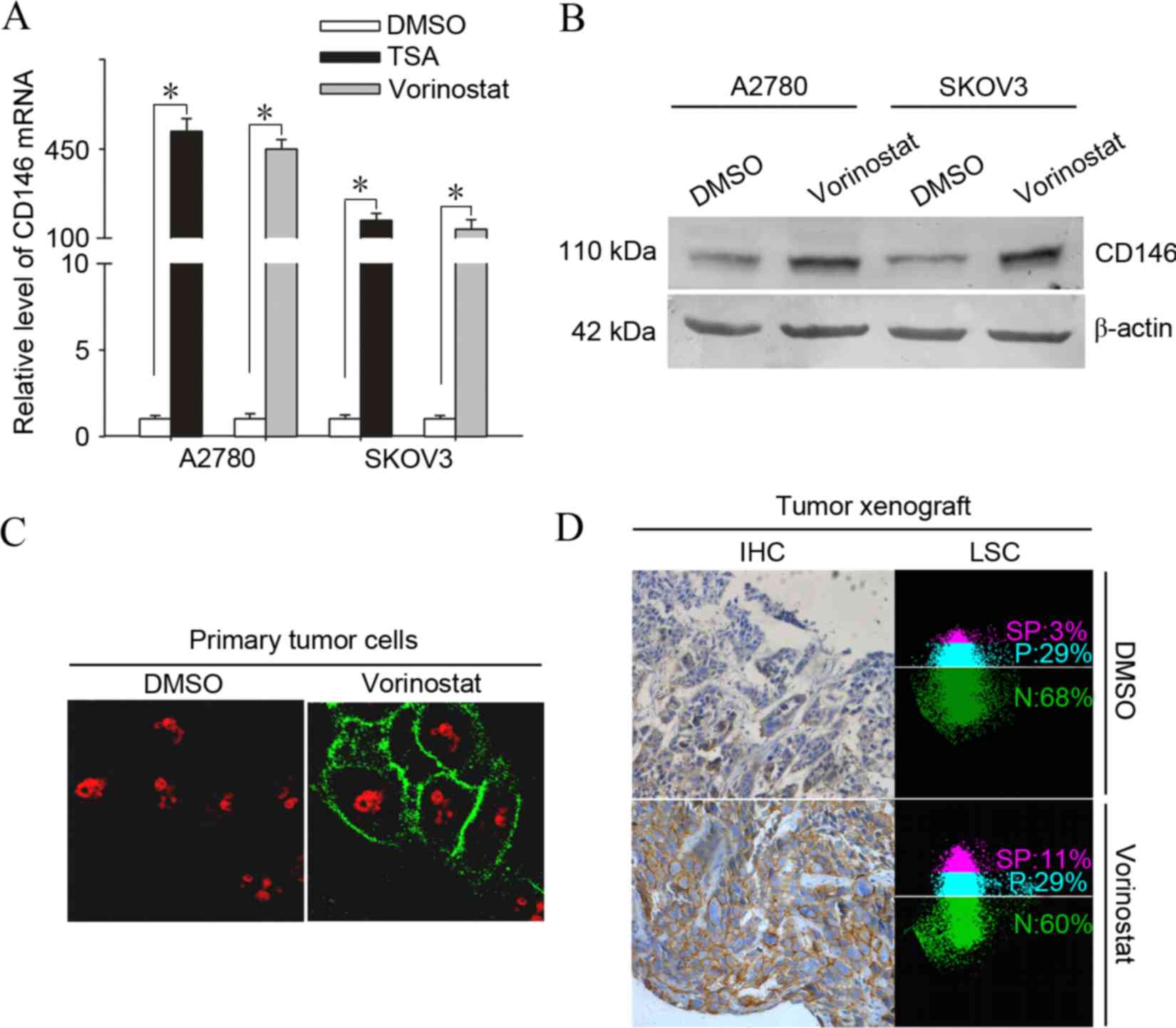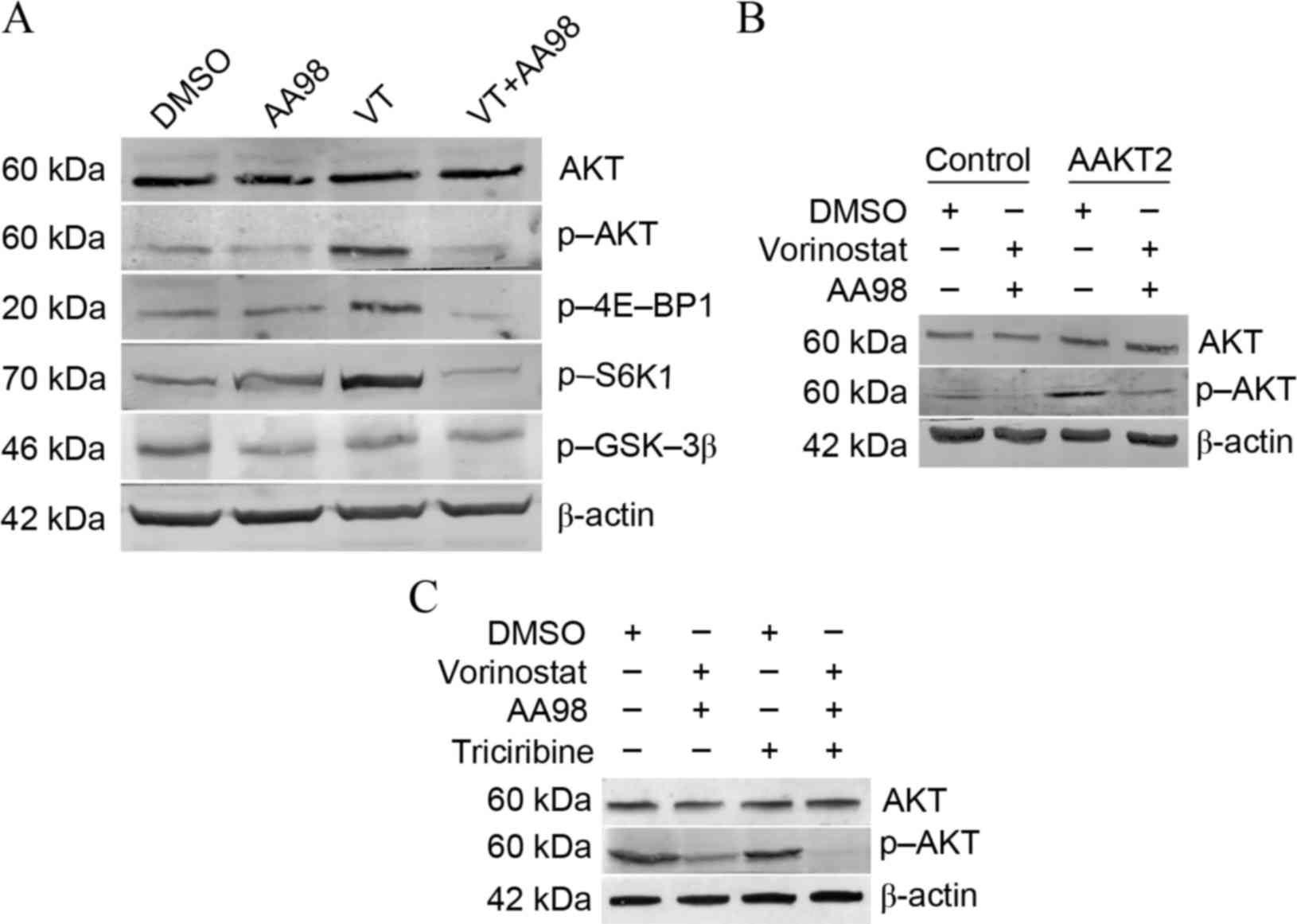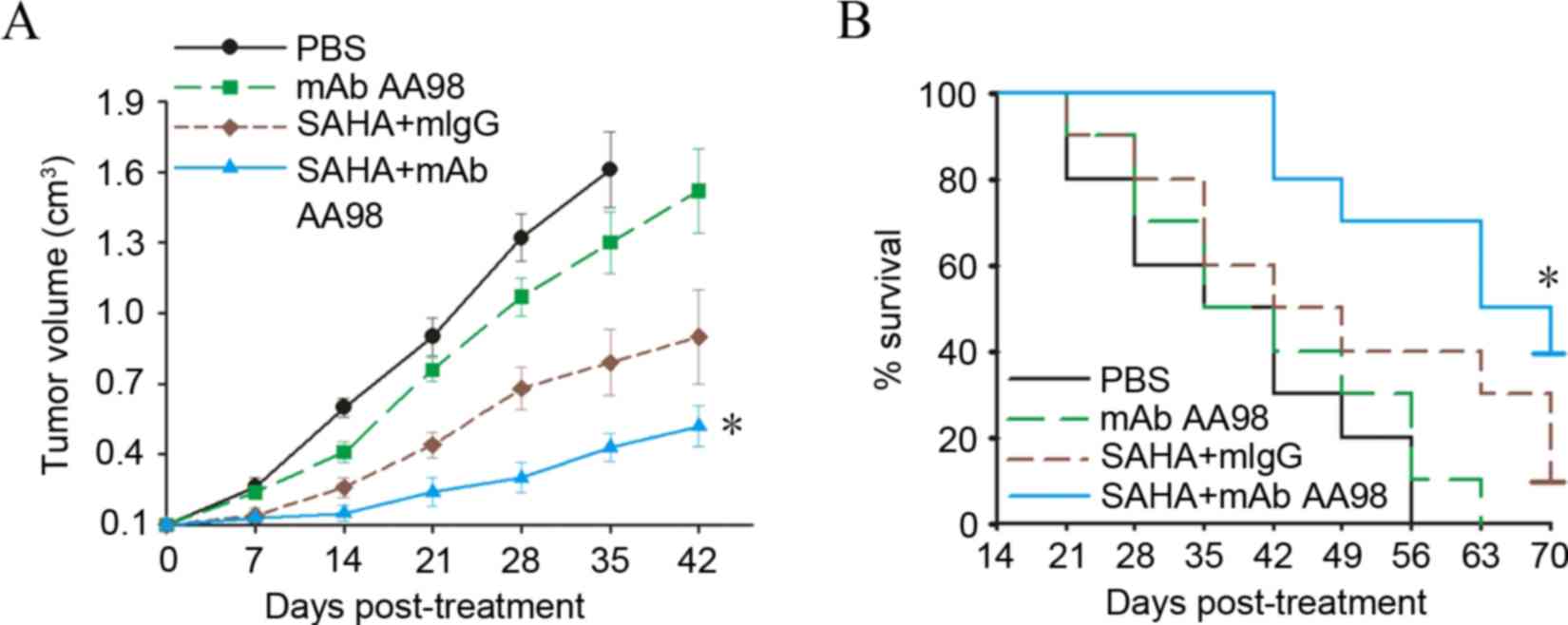|
1
|
Suh DH, Lee KH, Kim K, Kang S and Kim JW:
Major clinical research advances in gynecologic cancer in 2014. J
Gynecol Oncol. 26:156–167. 2015. View Article : Google Scholar : PubMed/NCBI
|
|
2
|
Jayson GC, Kohn EC, Kitchener HC and
Ledermann JA: Ovarian cancer. Lancet. 384:1376–1388. 2014.
View Article : Google Scholar : PubMed/NCBI
|
|
3
|
Zahedi P, Yoganathan R, Piquette-Miller M
and Allen C: Recent advances in drug delivery strategies for
treatment of ovarian cancer. Expert Opin Drug Deliv. 9:567–583.
2012. View Article : Google Scholar : PubMed/NCBI
|
|
4
|
Vecchione A, Belletti B, Lovat F, Volinia
S, Chiappetta G, Giglio S, Sonego M, Cirombella R, Onesti EC,
Pellegrini P, et al: A microRNA signature defines chemoresistance
in ovarian cancer through modulation of angiogenesis. Proc Natl
Acad Sci USA. 110:9845–9850. 2013. View Article : Google Scholar : PubMed/NCBI
|
|
5
|
Zwergel C, Valente S, Jacob C and Mai A:
Emerging approaches for histone deacetylase inhibitor drug
discovery. Expert Opin Drug Discov. 10:599–613. 2015. View Article : Google Scholar : PubMed/NCBI
|
|
6
|
Ma XL, Duan H, Liu J, Mo Q, Sun C, Ma D
and Wang J: Effect of LIV1 on the sensitivity of ovarian cancer
cells to trichostatin A. Oncol Rep. 33:893–898. 2015.PubMed/NCBI
|
|
7
|
West AC and Johnstone RW: New and emerging
HDAC inhibitors for cancer treatment. J Clin Invest. 124:30–39.
2014. View
Article : Google Scholar : PubMed/NCBI
|
|
8
|
Slingerland M, Guchelaar HJ and Gelderblom
H: Histone deacetylase inhibitors: An overview of the clinical
studies in solid tumors. Anticancer Drugs. 25:140–149. 2014.
View Article : Google Scholar : PubMed/NCBI
|
|
9
|
Højfeldt JW, Agger K and Helin K: Histone
lysine demethylases as targets for anticancer therapy. Nat Rev Drug
Discov. 12:917–930. 2013. View
Article : Google Scholar : PubMed/NCBI
|
|
10
|
Huang Z, Peng S, Knoff J, Lee SY, Yang B,
Wu TC and Hung CF: Combination of proteasome and HDAC inhibitor
enhances HPV16 E7-specific CD8+ T cell immune response and
antitumor effects in a preclinical cervical cancer model. J Biomed
Sci. 22:72015. View Article : Google Scholar : PubMed/NCBI
|
|
11
|
Straus DJ, Hamlin PA, Matasar MJ, Lia
Palomba M, Drullinsky PR, Zelenetz AD, Gerecitano JF, Noy A,
Hamilton AM, Elstrom R, et al: Phase I/II trial of vorinostat with
rituximab, cyclophosphamide, etoposide and prednisone as palliative
treatment for elderly patients with relapsed or refractory diffuse
large B-cell lymphoma not eligible for autologous stem cell
transplantation. Br J Haematol. 168:663–670. 2015. View Article : Google Scholar : PubMed/NCBI
|
|
12
|
Rasheed WK, Johnstone RW and Prince HM:
Histone deacetylase inhibitors in cancer therapy. Expert Opin
Investig Drugs. 16:659–678. 2007. View Article : Google Scholar : PubMed/NCBI
|
|
13
|
Ma X, Liu J, Wu J, Yan X, Wu P, Liu Y, Li
S, Tian Y, Cao Y, Chen G, et al: Synergistic killing effect between
vorinostat and target of CD146 in malignant cells. Clin Cancer Res.
16:5165–5176. 2010. View Article : Google Scholar : PubMed/NCBI
|
|
14
|
Wang Z and Yan X: CD146, a
multi-functional molecule beyond adhesion. Cancer Lett.
330:150–162. 2013. View Article : Google Scholar : PubMed/NCBI
|
|
15
|
Xie S, Luca M, Huang S, Gutman M, Reich R,
Johnson JP and Bar-Eli M: Expression of MCAM/MUC18 by human
melanoma cells leads to increased tumor growth and metastasis.
Cancer Res. 57:2295–2303. 1997.PubMed/NCBI
|
|
16
|
Wu GJ, Wu MW, Wang SW, Liu Z, Qu P, Peng
Q, Yang H, Varma VA, Sun QC, Petros JA, et al: Isolation and
characterization of the major form of human MUC18 cDNA gene and
correlation of MUC18 over-expression in prostate cancer cell lines
and tissues with malignant progression. Gene. 279:17–31. 2001.
View Article : Google Scholar : PubMed/NCBI
|
|
17
|
Zabouo G, Imbert AM, Jacquemier J, Finetti
P, Moreau T, Esterni B, Birnbaum D, Bertucci F and Chabannon C:
CD146 expression is associated with a poor prognosis in human
breast tumors and with enhanced motility in breast cancer cell
lines. Breast Cancer Res. 11:R12009. View
Article : Google Scholar : PubMed/NCBI
|
|
18
|
Leslie MC, Zhao YJ, Lachman LB, Hwu P, Wu
GJ and Bar-Eli M: Immunization against MUC18/MCAM, a novel antigen
that drives melanoma invasion and metastasis. Gene Ther.
14:316–323. 2007. View Article : Google Scholar : PubMed/NCBI
|
|
19
|
Xing S, Luo Y, Liu Z, Bu P, Duan H, Liu D,
Wang P, Yang J, Song L, Feng J, et al: Targeting endothelial CD146
attenuates colitis and prevents colitis-associated carcinogenesis.
Am J Pathol. 184:1604–1616. 2014. View Article : Google Scholar : PubMed/NCBI
|
|
20
|
Ma XL, Ma QF, Liu J, Tian Y, Wang B,
Taylor KM, Wu P, Wang D, Xu G, Meng L, et al: Identification of
LIV1, a putative zinc transporter gene responsible for
HDACi-induced apoptosis, using a functional gene screen approach.
Mol Cancer Ther. 8:3108–3116. 2009. View Article : Google Scholar : PubMed/NCBI
|
|
21
|
Satyamoorthy K, Muyrers J, Meier F, Patel
D and Herlyn M: Mel-CAM-specific genetic suppressor elements
inhibit melanoma growth and invasion through loss of gap junctional
communication. Oncogene. 20:4676–4684. 2001. View Article : Google Scholar : PubMed/NCBI
|
|
22
|
Lei X, Guan CW, Song Y and Wang H: The
multifaceted role of CD146/MCAM in the promotion of melanoma
progression. Cancer Cell Int. 15:32015. View Article : Google Scholar : PubMed/NCBI
|
|
23
|
Cooper AL, Greenberg VL, Lancaster PS, van
Nagell JR Jr, Zimmer SG and Modesitt SC: In vitro and in vivo
histone deacetylase inhibitor therapy with suberoylanilide
hydroxamic acid (SAHA) and paclitaxel in ovarian cancer. Gynecol
Oncol. 104:596–601. 2007. View Article : Google Scholar : PubMed/NCBI
|
|
24
|
Zeng Q, Wu Z, Duan H, Jiang X, Tu T, Lu D,
Luo Y, Wang P, Song L, Feng J, et al: Impaired tumor angiogenesis
and VEGF-induced pathway in endothelial CD146 knockout mice.
Protein Cell. 5:445–456. 2014. View Article : Google Scholar : PubMed/NCBI
|
|
25
|
Lheureux S, Karakasis K, Kohn EC and Oza
AM: Ovarian cancer treatment: The end of empiricism? Cancer.
121:3203–3211. 2015. View Article : Google Scholar : PubMed/NCBI
|
|
26
|
Modugno F and Edwards RP: Ovarian cancer:
Prevention, detection, and treatment of the disease and its
recurrence. molecular mechanisms and personalized medicine meeting
report. Int J Gynecol Cancer. 22:S45–S57. 2012. View Article : Google Scholar : PubMed/NCBI
|
|
27
|
Bots M and Johnstone RW: Rational
combinations using HDAC inhibitors. Clin Cancer Res. 15:3970–3977.
2009. View Article : Google Scholar : PubMed/NCBI
|
|
28
|
Khabele D: The therapeutic potential of
class I selective histone deacetylase inhibitors in ovarian cancer.
Front Oncol. 20:1112014.
|
|
29
|
Mohammad RM, Muqbil I, Lowe L, Yedjou C,
Hsu HY, Lin LT, Siegelin MD, Fimognari C, Kumar NB, Dou QP, et al:
Broad targeting of resistance to apoptosis in cancer. Semin Cancer
Biol. 35:(Suppl). S78–S103. 2015. View Article : Google Scholar : PubMed/NCBI
|
|
30
|
Ocana A, Vera-Badillo F, Al-Mubarak M,
Templeton AJ, Corrales-Sanchez V, Diez-Gonzalez L, Cuenca-Lopez MD,
Seruga B, Pandiella A and Amir E: Activation of the PI3K/mTOR/AKT
pathway and survival in solid tumours: Systematic review and
meta-analysis. PLoS One. 9:e952192014. View Article : Google Scholar : PubMed/NCBI
|
|
31
|
Feng D, Cao Z, Li C, Zhang L, Zhou Y, Ma
J, Liu R, Zhou H, Zhao W, Wei H and Ling B: Combination of valproic
acid and ATRA restores RARβ2 expression and induces differentiation
in cervical cancerthrough the PI3K/Akt pathway. Curr Mol Med.
12:342–354. 2012. View Article : Google Scholar : PubMed/NCBI
|
|
32
|
Moschetta M, Reale A, Marasco C, Vacca A
and Carratù MR: Therapeutic targeting of the mTOR-signalling
pathway in cancer: Benefits and limitations. Br J Pharmacol.
171:3801–3813. 2014. View Article : Google Scholar : PubMed/NCBI
|













